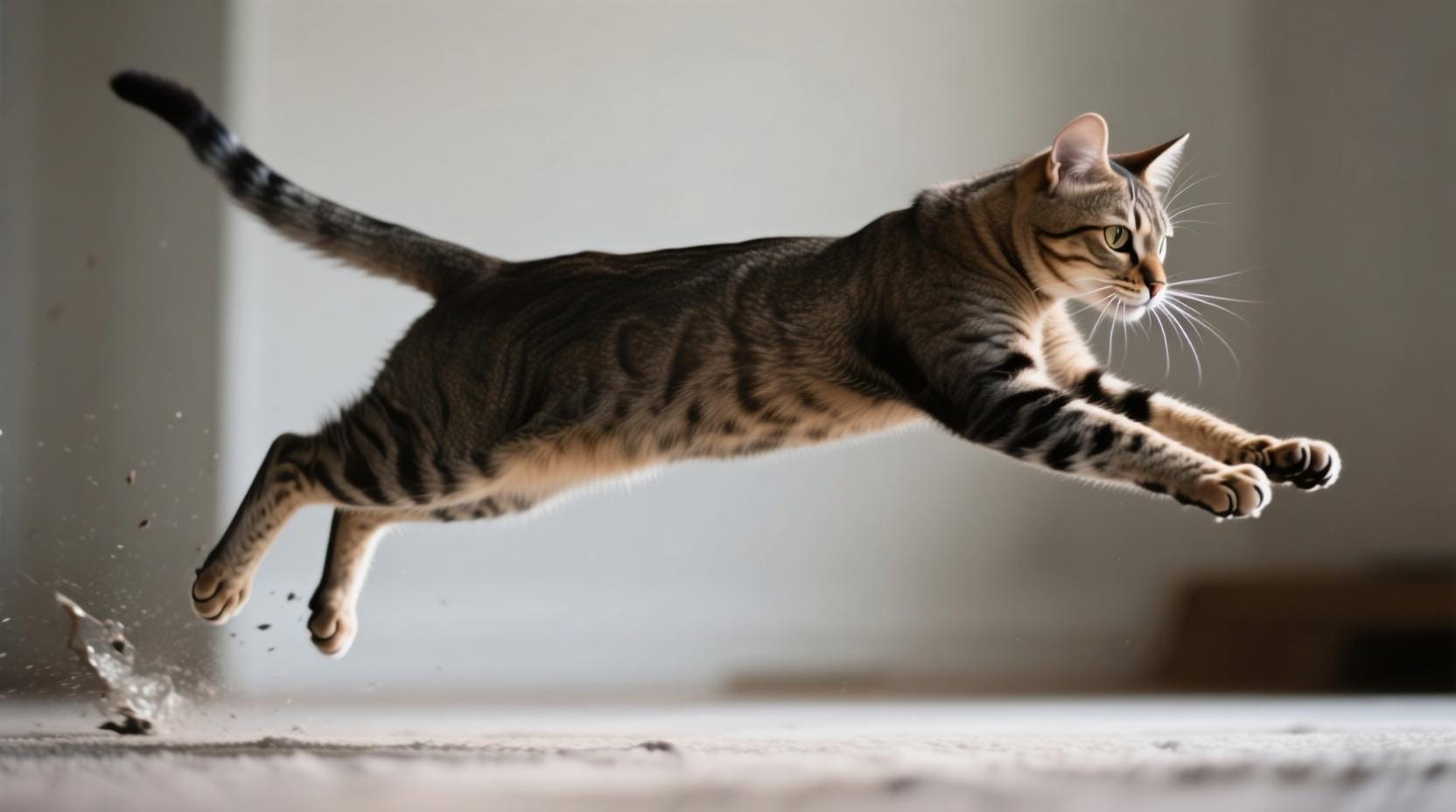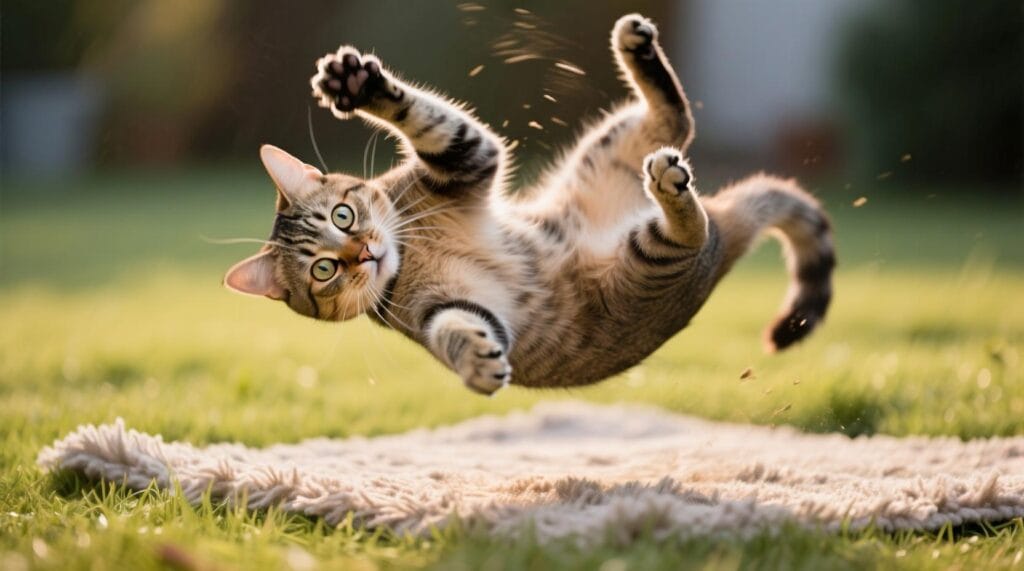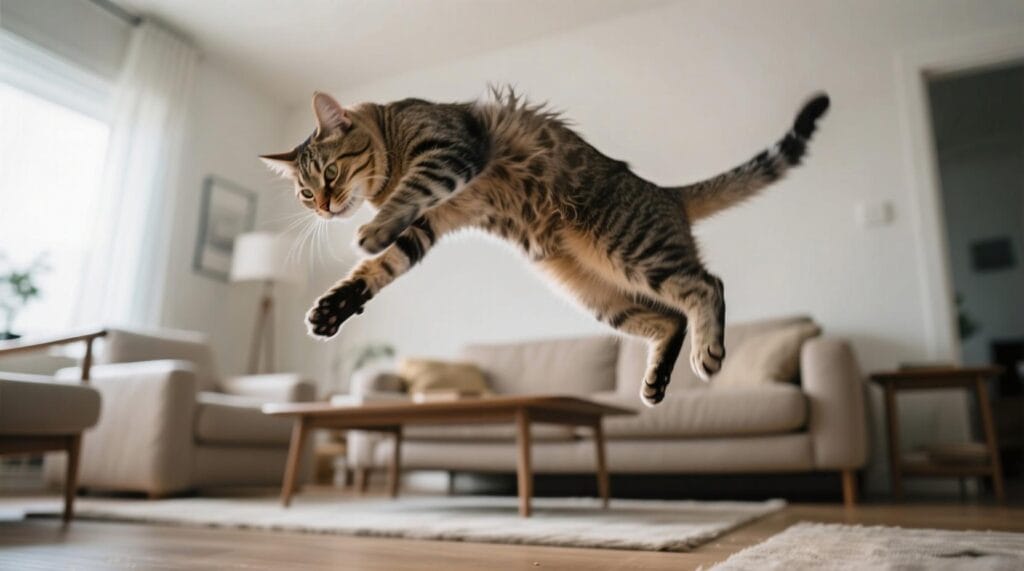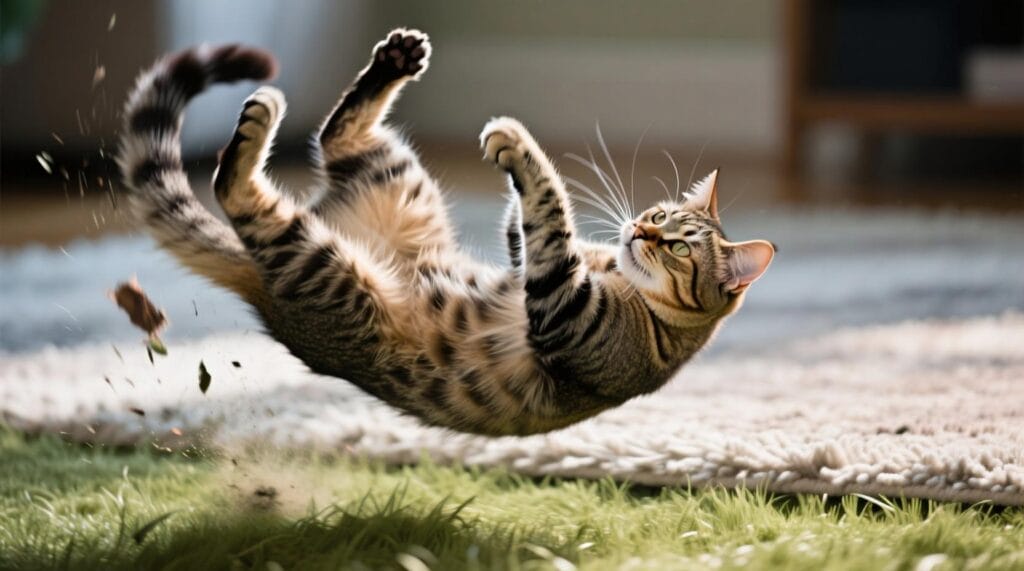
Table of Contents
Ever wondered how cats seem to defy gravity when falling? Their ability to land on their feet has puzzled many. Do cats always land on their feet?
This skill, called the cat righting reflex, is a remarkable adaptation. It lets cats orient themselves in mid-air. It’s not just luck but a complex biological mechanism.
Cats have a flexible spine and unique muscles. These help them twist and land safely. Scientists have studied this a lot, revealing the physics and biology behind it.
As you explore this topic, you’ll learn about the science behind cats’ aerial skills. You’ll discover the secrets of one of nature’s most impressive survival mechanisms.
Understanding the Cat Righting Reflex
Cats can land on their feet thanks to a special ability called the righting reflex. This skill lets them twist in mid-air for a safe landing.
What is the Righting Reflex?
The righting reflex is a survival tool for cats. It helps them rotate their body fast during a fall. Several key features help them:
- Extremely flexible spine
- No functional collarbone
- Highly developed vestibular system in the inner ear
When Does This Ability Develop?
Kittens start showing the righting reflex at 3-4 weeks old. This skill gets better as they grow, becoming almost perfect by 7 weeks.
Historical Scientific Observations
Scientists have always been amazed by cats’ landing skills. Early research showed their incredible mid-air moves. This is due to their unique body structure.
| Age | Righting Reflex Development |
|---|---|
| 0-3 weeks | Limited body control |
| 3-4 weeks | Initial righting reflex emerges |
| 7 weeks | Near-perfect landing ability |
The cat’s ability to land on its feet is not magic, but a result of remarkable evolutionary adaptation.
The Physics Behind Feline Falls
When a cat falls, something amazing happens. They can land on their feet thanks to physics. Their mid-air moves are not magic but follow the laws of physics.
Cats use angular momentum and moment of inertia to fall right. They twist and turn in the air to land perfectly:
- They first rotate their head toward the ground
- Their flexible spine enables a unique twisting motion
- Front and back body segments move independently
This amazing reflex shows how cats use physics to land on their feet. Their body acts like a gyroscope, making small adjustments in mid-air.
“A cat’s fall is less about luck and more about precise biomechanical engineering” – Animal Physics Research
The physics of cats landing on their feet involves three key stages:
- Orientation detection: Sensing their position in space
- Body realignment: Twisting to face downward
- Impact preparation: Positioning legs for landing
By understanding these stages, you can see the amazing physics behind cats’ safe landings.
Do Cats Land on Their Feet Every Time?
Cats can land on their feet most of the time, thanks to their amazing righting reflex. But, they’re not always safe during falls.
A study from the New York Animal Medical Center in 1987 found some cool facts about cats’ falling skills. They looked at 132 cats that fell from high-rise buildings. Amazingly, 90% of them survived.
Success Rate Statistics
It’s clear that cats can land on their feet, and it’s not just a myth. They have a special survival mechanism:
- 90% survival rate in high-rise falls
- Unique ability to rotate mid-air
- Natural shock-absorption techniques
Factors Affecting Landing Success
Several things can affect a cat’s chance to land safely:
- Fall height
- Cat’s age and physical condition
- Initial body orientation
- Reaction time
Limitations of the Reflex
Even with their amazing skills, cats can’t always land safely. Their righting reflex has its limits. Short or sudden falls might not give them enough time to adjust.
| Fall Scenario | Landing Success Probability |
|---|---|
| Low-height falls (under 2 feet) | 60-70% |
| Medium-height falls (2-5 feet) | 80-85% |
| High-rise falls (above 5 feet) | 90-95% |
Remember, while cats have an extraordinary ability to land on their feet, prevention is always the best approach to keeping your feline friend safe.
Anatomical Advantages of Cats
Cats have amazing body features that let them land on their feet with great skill. Their unique design is a result of evolution, making them experts at falling. They can do things that seem impossible to us.
The key to a cat’s landing ability is their skeleton and muscles. Their spine is made of 30 very flexible vertebrae. This lets cats move in ways that other animals can’t.
- Extremely flexible spine with 30 vertebrae
- Powerful and responsive muscle groups
- Lightweight and agile body structure
- Highly developed vestibular system in the inner ear
When cats fall, their amazing body takes over. Their righting reflex lets them twist in mid-air. This way, they can land safely. Several key features help them do this:
- Loose skin that allows free movement
- Extremely strong back muscles
- Exceptional balance and coordination
- Shock-absorbing leg muscles
These features work together to let cats land on their feet with amazing success. Their body acts like a gyroscope, making quick adjustments during a fall.
The Role of the Flexible Spine
When we look at how cats land on their feet, their spine is key. Their unique skeleton lets them do amazing things in mid-air. It’s like magic.
Cats have a special spine that helps them land on their feet with great skill. They have 30 vertebrae, unlike humans’ 33. This gives them several big advantages:
- Increased flexibility for twisting
- Enhanced range of motion
- Rapid body repositioning
Vertebrae Structure
Each vertebra in a cat’s spine is connected with very elastic ligaments. This lets cats do what seems impossible in mid-air. When they fall, these vertebrae act like a shock-absorbing system. They help cats move precisely while falling.
Muscle Coordination
The spine’s flexibility works well with a cat’s muscles. Special muscles around the spine let cats make quick changes during falls. They can twist, rotate, and adjust their body fast. This ensures they can land on their feet with amazing consistency.
A cat’s spine is like a living, breathing gyroscope – constantly recalibrating to maintain balance and control.
Terminal Velocity and Cat Falls

Understanding terminal velocity is key when we talk about cats landing on their feet. Cats have a special ability to survive falls that would harm others. This skill is due to their unique terminal velocity.
Terminal velocity is the top speed an object reaches when falling, when air resistance equals gravity’s pull. Cats fall much slower than humans. An average cat can hit about 60 mph (97 km/h), much slower than a human.
“Cats have evolved a remarkable falling mechanism that transforms potential danger into a survivable experience.” – Veterinary Biomechanics Research
The low terminal velocity helps cats land safely. It lets them spread out the impact of a fall. This is why cats often land on their feet without getting hurt.
- Terminal velocity for cats: 60 mph
- Human terminal velocity: Approximately 120 mph
- Cats can survive falls from significant heights due to their unique falling mechanics
Knowing about terminal velocity explains why cats often survive falls that seem impossible. Their ability to land on their feet is real and scientifically backed.
| Animal | Terminal Velocity | Survival Adaptations |
|---|---|---|
| Domestic Cat | 60 mph | Righting reflex, flexible spine |
| Human | 120 mph | Limited natural falling mechanisms |
| Small Rodent | 30 mph | Low body mass, air resistance |
This special trait of terminal velocity shows why cats are amazing survivors in the animal world.
Height Impact on Survival Rates
Researchers have found interesting facts about cats landing on their feet. They looked at how high cats fall and how it affects their survival. The link between how high cats fall and their injuries is more complex than you might think.
In 1987, a key study on cat falls was done. It showed how important it is for cats to land on their feet, especially when they fall from different heights.
Statistical Findings on Cat Falls
The study found a surprising pattern of injuries:
- Falls from lower heights (1-3 stories) caused more serious injuries
- Falls from mid-range heights (4-6 stories) increased injury potential
- Falls from higher heights (7+ stories) surprisingly had less injury severity
Understanding Optimal Fall Heights
When cats fall from higher places, they have more time to use their righting reflex. This extra time helps them:
- Rotate their body just right
- Spread out to absorb the impact
- Get their muscles ready for landing
The physics behind cats landing on their feet is truly amazing at higher altitudes. It lets them use their natural survival skills fully.
The Science of Air Resistance
When we look at how cats land on their feet, air resistance is key. Cats have a special way to control their body during falls. This creates a natural drag that slows them down.
The physics of cats landing on their feet is fascinating. Unlike others, cats spread out their body to increase air resistance. This helps them fall slower and avoid injuries.
- Cats can rotate their body mid-fall
- They adjust limb positioning to create drag
- Their flexible spine enables rapid body repositioning
Biomechanical adaptations make cats amazing in the air. Their righting reflex works with air resistance. This lets them quickly turn and lessen the impact of falls.
Studies show cats can slow their fall by spreading out. This is like how flying squirrels use drag. It shows how cats have evolved to survive dangerous falls.
“Nature has equipped cats with remarkable survival mechanisms that defy simple physical limitations.” – Animal Biomechanics Research Institute
Cat’s Landing Mechanics
Cats have amazing landing skills. They can turn a fall into a smooth landing. This is thanks to their incredible body control.

Let’s look at how cats land on their feet. They have special physical abilities. These help them avoid getting hurt when they fall.
Leg Position During Falls
Here’s what cats do when they fall:
- First, they rotate their head to figure out which way is down.
- Next, they twist their flexible spine to line up their body.
- Then, they stretch out their legs ready for landing.
- Finally, they adjust their legs to spread out the impact.
Impact Distribution
Cats can land on their feet because of their shock absorption. They place their legs to spread out the force of landing.
“Cats transform potential injury into a calculated, controlled descent.” – Feline Biomechanics Research Institute
Here’s how cats land safely:
| Landing Phase | Biomechanical Action | Impact Reduction |
|---|---|---|
| Initial Contact | Limb Flexion | 50-60% Force Absorption |
| Weight Transfer | Rolling Motion | 30-40% Force Dissipation |
| Final Stabilization | Muscle Tension | 10-20% Remaining Force |
Their amazing reflex helps them land safely. This shows how incredible feline biomechanics are.
Comparing Cat Falls to Other Animals
It’s interesting to see that cats aren’t the only ones who can land on their feet. Many animals have similar abilities to right themselves in mid-air. This helps them survive when they fall unexpectedly.
Small vertebrates like rabbits and rats can also rotate their bodies during a fall. Some lizards and even certain insects have basic control over their position in the air.
- Rabbits can perform limited body rotations
- Rats exhibit similar righting capabilities
- Certain lizards can control their body position mid-fall
- Some invertebrate arthropods show rudimentary aerial control
Not just cats benefit from this ability. Each species has its own way to protect itself from injury when it falls. This shows how diverse and clever nature can be.
| Animal | Righting Reflex Capability | Rotation Speed |
|---|---|---|
| Cats | Exceptional | 180 degrees within 1 foot |
| Rabbits | Limited | 90 degrees partial rotation |
| Rats | Moderate | 120 degrees mid-fall |
| Lizards | Adaptive | Variable based on species |
Cats are the top aerial performers, but other animals have their own amazing skills. Learning about these abilities helps us see how incredible animals are.
Safety Considerations for Cat Owners
Keeping your cat safe from falls is very important. Cats can land on their feet, but it’s better to prevent falls. This keeps your pet out of danger.
Knowing the risks of falls helps make a safer place for your cat. The term High-Rise Syndrome shows the dangers cats face at high heights.
Essential Prevention Strategies
- Install secure window screens with strong mesh
- Keep balcony and window areas blocked or supervised
- Remove furniture near windows that cats might use to jump
- Maintain a healthy weight for your cat to improve mobility
Addressing High-Rise Syndrome
Overweight cats are more at risk and less likely to land on their feet. Vets suggest keeping your cat at a healthy weight. This can be done with the right diet and exercise.
Critical Safety Measurements
Creating a safe indoor space is more than just stopping falls. Here are more safety tips:
- Regular veterinary check-ups
- Keeping toxic substances out of reach
- Providing safe climbing and perching areas
- Using pet-proofing techniques in multi-level homes
Remember, a few preventive measures can significantly reduce the risk of serious injury to your feline companion.
Common Misconceptions About Cat Falls

Many people think cats always land on their feet safely. This belief can be dangerous for cats. Cats can’t always right themselves perfectly.
Let’s look at some common myths about cat falls:
- Cats can survive falls from any height – This is not true. Cats can right themselves well, but high falls can still hurt them.
- Cats never get hurt when falling – Falls can cause big injuries, like broken bones and head trauma.
- The righting reflex works perfectly every time – Cats’ ability to land on their feet depends on many things, like how high they fall and how fast they react.
Vets say cats can get hurt badly from falls, known as “high-rise syndrome.” Thinking cats are always safe can stop owners from keeping them safe.
Not all falls are survivable, and every precaution should be taken to protect your feline friend from potential dangerous situations.
Knowing the truth about cat falls helps keep your pet safe. Cats have amazing reflexes, but they can still get hurt.
Medical Implications of Falls
When cats fall, they might not always land perfectly on their feet. It’s important for pet owners to know the possible medical issues. While cats have a great righting reflex, falls can still cause serious injuries.
Veterinary experts say there are several key medical issues from cat falls:
- Traumatic orthopedic injuries
- Internal organ damage
- Soft tissue trauma
- Potential neurological complications
Do cats land on their feet every time? Not always. Falls can lead to serious health problems that need quick vet care. Common injuries include:
- Broken bones – especially in legs and pelvis
- Collapsed lung
- Internal bleeding
- Head trauma
“Even cats with exceptional landing abilities can suffer serious medical consequences from unexpected falls.” – Veterinary Trauma Specialists
Diagnosing these injuries often involves detailed physical checks, X-rays, and sometimes CT scans. The treatment plan is made based on the injuries found.
Preventing falls is the best way to keep your cat safe. By avoiding high-risk situations, you can lower the chance of these serious health issues.
Research and Studies on Feline Falls
Scientists have always been curious about how cats land on their feet. Their ability to do so has led to many studies on their unique physical skills.
Important research into cat falls started with a 1987 study at the New York Animal Medical Center. This study gave us key insights into the cat’s righting reflex.
- 1987 New York Animal Medical Center research highlighted the precise movements cats use to orient themselves during falls
- 2003 follow-up studies examined the biomechanical details of cat landings
- Researchers analyzed high-speed video footage to understand the intricate body movements
Cats have an amazing ability to rotate their bodies mid-fall. This righting reflex lets them twist and land feet-first with great accuracy.
The scientific world is amazed by cats’ ability to land on their feet. Studies have shown the complex processes behind this skill.
The cat’s ability to survive falls from significant heights continues to amaze researchers and challenge our understanding of animal physics.
Today, we know more about how cats fall and land. This knowledge helps us understand their unique physical advantages.
Conclusion
Cats’ ability to land on their feet is amazing. It shows how nature can design incredible things. But, it’s important to know that cats don’t always land on their feet.
They have a special righting reflex. This, along with their flexible spine and air resistance skills, helps them land well. But, it’s not a sure thing every time.
Knowing about cats’ landing abilities means understanding both their amazing skills and limits. Studies show cats have a strong survival instinct. But, things like height, how they fall, and their health can affect their landing.
So, it’s up to us to keep our cats safe. This means avoiding dangerous falls, especially in tall places.
The righting reflex is a great example of how cats have adapted over time. They can turn themselves around in mid-air. But, they’re not completely safe.
Protecting your cat from falls is the best way to keep them safe. This is more important than their amazing reflexes.
Learning about how cats fall helps us appreciate their amazing abilities. But, we must also be careful to keep them safe. Awareness and prevention are key to protecting our cats.
Sources about do cats land on their feet:
1. National Geographic – How Cats Always Land on Their Feet
Explains the science behind cats’ ability to land on their feet, including the righting reflex and flexible spine.
Link:
https://www.nationalgeographic.com/animals/article/how-cats-always-land-on-their-feet
2. Scientific American – Why Do Cats Land on Their Feet?
Details the biomechanics and neurological reflexes that help cats twist midair and land safely.
Link:
https://www.scientificamerican.com/article/why-do-cats-land-on-their-feet/
3. American Veterinary Medical Association (AVMA) – Cat Righting Reflex
Provides a vet perspective on the cat’s righting reflex and common injuries from falls.
Link:
https://www.avma.org/resources-tools/pet-owners/petcare/cat-righting-reflex
4. Live Science – Why Do Cats Land on Their Feet?
Breaks down the physics and anatomy behind cats’ midair rotations.
Link:
https://www.livescience.com/why-cats-land-on-feet.html
5. Cornell University College of Veterinary Medicine – Cat Falls and Injuries
Research-based overview of cats’ fall survival mechanisms and the “cat righting reflex.”
FAQ
Do cats always land on their feet?
No, cats don’t always land on their feet. They have a great righting reflex, but it’s not perfect. Things like how high they fall and how fast they react can affect their landing.
At what height do cats become most vulnerable during a fall?
Falls from medium heights (2-5 stories) can be more dangerous than very high ones. A 1987 New York study found that cats falling from higher floors might actually have a better chance of landing safely.
How do cats manage to twist in mid-air?
Cats twist in mid-air thanks to their flexible spine and special skeletal structure. They can move their head, front, and back body separately. This helps them turn to land on their feet.
What is the cat righting reflex?
The cat righting reflex is how cats turn to land on their feet during a fall. It’s a skill they learn early in life. It involves their spine, muscles, and balance system working together.
Can cats survive falls from great heights?
Cats have a good chance of surviving falls because of their righting reflex and terminal velocity. But, falls can still hurt them. It depends on how high they fall, where they land, and how they position their body.
How do cats slow their fall?
Cats slow their fall by spreading out like a parachute. This increases drag and lowers their speed. They can adjust their body to get the most air resistance and reduce impact.
Do all cats have the same falling ability?
No, cats’ falling ability varies. It depends on their age, weight, flexibility, and health. Younger, more agile cats usually have a better righting reflex than older or less fit ones.
What is High-Rise Syndrome?
High-Rise Syndrome is the injuries cats get from falling from high buildings. Even with their righting reflex, they can still get hurt badly. This includes broken bones and internal injuries.
How early do cats develop the righting reflex?
Kittens start developing the righting reflex at 3-4 weeks old. As they grow, their ability to right themselves gets better. This is due to improved motor skills and spatial awareness.
Are there ways to prevent cat falls?
Yes, you can prevent cat falls. Secure windows with screens, keep balconies closed, and remove furniture near high windows. Also, always watch your cat in areas that could be dangerous.





